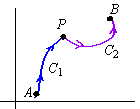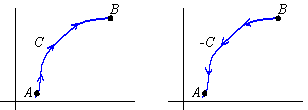Part 4: Properties of Line Integrals
The usual properties of integration also hold for line integrals,
such as
where k is a constant. Moreover, if r( t) , t in [ a,b] , parametrizes a curve C, then the arclength
parametrization is of the form r( t( s) )
for s in [ a,b] . It then follows that
|
|
ó
õ
|
C
|
F·dr = |
ó
õ
|
b
a
|
F· |
dr
dt
|
dt = |
ó
õ
|
b
a
|
F· |
dr
dt
|
|
dt
ds
|
ds = |
ó
õ
|
b
a
|
F· |
dr
ds
|
ds |
| (7) |
That is, the line integral over any parametrization of C can be
transformed into an integral over the arclength parameter, thus implying
that any two different parametrizations of C yield the same value for the
line integral.
Indeed, the properties of line integrals closely resemble the properties of
ordinary integrals. For example, if C1 is a curve that begins at A
and ends at P, and if C2 is a curve that begins at P and ends at B, then their union is defined to be the curve C1ÈC2
that progresses along C1 from A to P and then along C2 from P
to B:

It is straightforward to show that
|
|
ó
õ
|
C1ÈC2
|
F·dr = |
ó
õ
|
C1
|
F·dr+ |
ó
õ
|
C2
|
F·dr |
| (8) |
(see exercises 35 and 36).
Moreover, if C is a curve parametrized by r( t) =
á x( t) ,y( t)
ñ , t in [ a,b] , then the curve -C is the curve parametrized by r( t) =
á x( -t) ,y( -t)
ñ , t in [ -b,-a] , and consequently, is the
same as C but with the opposite orientation.

It is also straightforward to show that
EXAMPLE 7 If C is the union of two curves C1 and C2, and if
|
|
ó
õ
|
C1
|
F ·dr = 3, |
ó
õ
|
C2
|
F·dr = 7 |
|
then what is ò-C F·dr?
Solution: To begin with, we must have
Moreover, since C = C1ÈC2, we further have
|
|
|
| |
|
|
- |
é
ë
|
|
ó
õ
|
C1
|
F·dr+ |
ó
õ
|
C2
|
F·dr |
ù
û
|
|
| |
|
| |
|
|
|


